A Comparative Study of Models for the Construction Duration Prediction in Highway Road Projects of India
Abstract
1. Introduction
2. Research Methodology
2.1. Research Study
2.2. Overview
2.3. Analysis
2.4. Exponential Smoothing Techniques
2.5. Bromilow’s Time–Cost Model
2.6. Artificial Neural Network (ANN)
2.7. Time Series Analysis
3. Results and Discussion
4. Conclusions
Author Contributions
Funding
Institutional Review Board Statement
Informed Consent Statement
Data Availability Statement
Conflicts of Interest
References
- Jarkas, A.M. Predicting Contract Duration for Building Construction: Is Bromilow’s Time-Cost Model a Panacea? J. Manag. Eng. 2016, 32, 05015004. [Google Scholar] [CrossRef]
- Dursun, O.; Stoy, C. Determinants of construction duration for building projects in Germany. Eng. Constr. Arch. Manag. 2012, 19, 444–468. [Google Scholar] [CrossRef]
- Walker, D.H.T. An investigation into construction time performance. Constr. Manag. Econ. 1995, 13, 263–274. [Google Scholar] [CrossRef]
- Kumaraswamy, D.D. A comparative study of causes of time overruns in Hong Kong construction projects. Int. J. Proj. Manag. 1997, 15, 55–63. [Google Scholar]
- Skitmore, M.A. Australian project-time analysis: Statistical analysis of intertemporal trends. Constr. Manag. Econ. 2001, 19, 455–458. [Google Scholar]
- Le-Hoai, L.N. Estimating time performance for building construction projects in Vietnam. KSCE J. Civ. Eng. 2013, 17, 1–8. [Google Scholar] [CrossRef]
- Bromilow, F. Contract time performance expectations and reality. Build. Forum. 1969, 1, 70–80. [Google Scholar]
- Abdelhamid, T.S.; Everett, J.G. Time Series Analysis for Construction Productivity Experiments. J. Constr. Eng. Manag. 1999, 125, 87–95. [Google Scholar] [CrossRef]
- Al-Ghafly, M.I.-K. Important causes of delay in public utility projects in Saudi Arabia. Constr. Manag. Econ. 1999, 17, 647–655. [Google Scholar]
- Shr, J.F.; Chen, W.T. Functional model of cost and time for highway construction projects. J. Mar. Sci. Technol. 2006, 14, 127–138. [Google Scholar]
- Ammar, K. Relationship between value and duration of construction projects. Constr. Manag. Econ. 1991, 9, 383–400. [Google Scholar]
- Maia, A.L. Holt’s exponential smoothing and neural network models for forecasting interval-valued time series. Int. J. Forecast. 2011, 27, 740–759. [Google Scholar] [CrossRef]
- Love, P.T. Time-cost relationships in Australian building construction projects. J. Constr. Eng. Manag. 2005, 131, 187–194. [Google Scholar] [CrossRef]
- Aziz, A.M. Time Prediction for Highway Pavement Projects Using Regression Analysis. In Proceedings of the Construction Research Congress 2009, Seattle, DC, USA, 5–7 April 2009. [Google Scholar]
- Skitmore, M.A. Available online: https://www.tandfonline.com/doi/abs/10.1080/01446193.2001.9709621 (accessed on 29 November 2010).
- Brown, R.G. The fundamental theory of exponential smoothing. Opera. Res. 1961, 9, 673–685. [Google Scholar] [CrossRef]
- Czajkowska, A.; Kadłubek, M. Managment factors affecting quality of processes in Construction Enterprises. Pol. J. Manag. Stud. 2005, 10, 28–38. [Google Scholar]
- Dvorský, J.; Petráková, Z.; Ajaz, K.K.; Formánek, I.; Mikoláš, Z. Selected aspects of strategic management in the service sector. J. Tour. Serv. 2020, 20, 109–123. [Google Scholar] [CrossRef]
- Androniceanu, A.; Kinnunen, J.; Georgescu, I. E-Government clusters in the EU based on the Gaussian Mixture Models. Adm. Manag. Public 2020, 35, 6–20. [Google Scholar]
- Dong-Jun, Y.; Hae-Mi, S.; Yoo-Jun, K.; Chung-Suk, C.; Youngsuk, K. Development of an approximate construction duration prediction model during the project planning phase for general office buildings. Int. J. Civ. Eng. Manag. 2018, 24, 238–253. [Google Scholar]
- Yoo-Jun, K.; Dong-Jun, Y.; Young, S.K. Development of construction duration prediction model for project planning phase of mixed-use buildings. J. Asian Archit. Build. Eng. 2019, 18, 586–598. [Google Scholar]
- Daniela, M.; Maria, K.; Renata, B.; Marcela, S.; Katarina, K. Construction-Duration Prediction Model for Residential Buildings in Slovak Republic Based on Computer Simulation. Int. J. Appl. Eng. Res. 2017, 12, 3590–3599. [Google Scholar]
- Arditi, D.; Akan, G.T.; Gurdamar, S. Reasons for delays in public projects in Turkey. Constr. Manag. Econ. 1985, 3, 171–181. [Google Scholar] [CrossRef]
- Androniceanu, A.; Tvaronavičienė, M. Developing a holistic system for social assistance services based on effective and sustainable partnerships. Adm. Manag. Public 2019, 33, 103–118. [Google Scholar] [CrossRef]
- Wichan, P.; Thammasak, R.; Vannee, S. Forecasting Final Budget and Duration of Highway Construction Projects. Eng. Constr. Archit. Manag. 2009, 16, 544–557. [Google Scholar] [CrossRef]
- Muhammad, I.; Muhammad, B.K.; Panagiotis, C. Planning stage estimation of highway project duration on basis of project cost, project type and contract type. Int. J. Proj. Manag. 2011, 29, 78–92. [Google Scholar]
- Anupam, S.; Rajesh, T.; Ramtekkar, G.D. A Survey on Cost and Time management in Highway Construction Projects. Int. J. Sci. Dev. Res. (IJSDR) 2017, 2, 426–427. [Google Scholar]
- Jansi, R.K.; Kavitha, M.S.; Kot, S.; Hariharasudan, A. Socia-economic, hygiene and nutritional status of Indian slums: A scoping review. J. Public Health Res. Dev. 2019, 10, 128–132. [Google Scholar] [CrossRef]
- Vanhoucke, M. Project Management with Dynamic Scheduling, Risk Analysis and Project Control; Springer: Berlin/Heidelberg, Germany, 2012; pp. 11–35. [Google Scholar]
- Bromilow, F. Measurement and scheduling of construction time and cost performance in the building industry. Chart. Build. 1974, 10, 54–67. [Google Scholar]
- Ogunsemi, D.R. Time-cost model for building projects in Nigeria. Constr. Manag. Econ. 2007, 24, 253–258. [Google Scholar] [CrossRef]
- Czarnigowska, A.; Sobotka, A. Time-cost relationship for predicting construction duration. Arch. Civ. Mech. Eng. 2013, 13, 518–526. [Google Scholar] [CrossRef]
- Ord, J.K. Estimation and Prediction for a class of dynamic nonlinear statistical models. J. Am. Stat. Assoc. 1997, 92, 311–315. [Google Scholar] [CrossRef]
- Gardner. Exponential smoothing: The state of the art. J. Forecast. 1985, 22, 1–28. [Google Scholar]
- Taylor, J.W. Exponential smoothing with a damped multiplicative trend. Int. J. Forecast. 2003, 19, 715–725. [Google Scholar] [CrossRef]
- Maia, A.L. Available online: https://www.sciencedirect.com/science/article/abs/pii/S0169207010000506 (accessed on 2 June 2010).
- Homayoun, K.A.A. Project duration forecasting using earned duration management with exponential smoothing techniques. J. Manag. Eng. 2016, 33, 04016032. [Google Scholar]
- Ireland, V. The Role of Managerial Actions in the Cost, Time and Quality Performance of High-Rise Commercial Building Projects. Ph.D. Thesis, University of Sydney, Sydney, Australia, 1983. [Google Scholar]
- Bromilow, F.A. Procedures for reckoning and valuing the performance of building contracts. Chart. Build. 1976, 10, 57. [Google Scholar]
- Bromilow, F.E. AIQS survey of building contract time performance. Build. Econ. 1980, 19, 79–82. [Google Scholar]
- Chan, A.P. Time-cost relationship of public sector projects in Malaysia. Int. J. Proj. Manag. 1980, 19, 223–229. [Google Scholar] [CrossRef]
- Love, P.E. Influence of project type and procurement method on rework costs in building construction projects. J. Constr. Eng. Manag. 2002, 128, 18–29. [Google Scholar] [CrossRef]
- Chan, D.W.; Kumaraswamy, M.M. Modeling and predicting construction durations in Hong Kong public housing. Constr Manag. Econ. 1999, 17, 351–362. [Google Scholar] [CrossRef]
- Le-Hoai, L.; Young, D.L. Time-cost relationships of building construction project in Korea. Facilities 2009, 27, 549–559. [Google Scholar] [CrossRef]
- Elhag, T.M. Cost Modeling: Neural networks vs. regression techniques. In Proceedings of the International Conference on Construction Information Technology (INCITE), Langkawi, Malaysia, 18–21 February 2004; Construction Industry Development Board Malaysia (CIDB): Selangor, Kuala Lumpur, Malaysia, 2004. [Google Scholar]
- Wang, Y.R.; Gibson, G.E., Jr. A Study of Pre project Planning and Project Success Using ANN and Regression Models. Autom. Constr. 2010, 19, 341–346. [Google Scholar] [CrossRef]
- Zhang, Y. Forecasting Completed Cost of Highway Construction Projects Using LASSO Regularized Regression. Available online: https://ascelibrary.org/action/showCitFormats?doi=10.1061%2F%28ASCE%29CO.1943-7862.0001378 (accessed on 1 April 2021).
- Pandit, S.M. Time Series and System Analysis with Applications; Krieger Pub Co.: Malabar, FL, USA, 1993. [Google Scholar]
- Velumani, P. Predicting India’s Cement Price: A comparison of Regression analysis, Trend analysis and artificial neural network. Int. J. Civ. Eng. Technol. 2018, 9, 1907–1915. [Google Scholar]
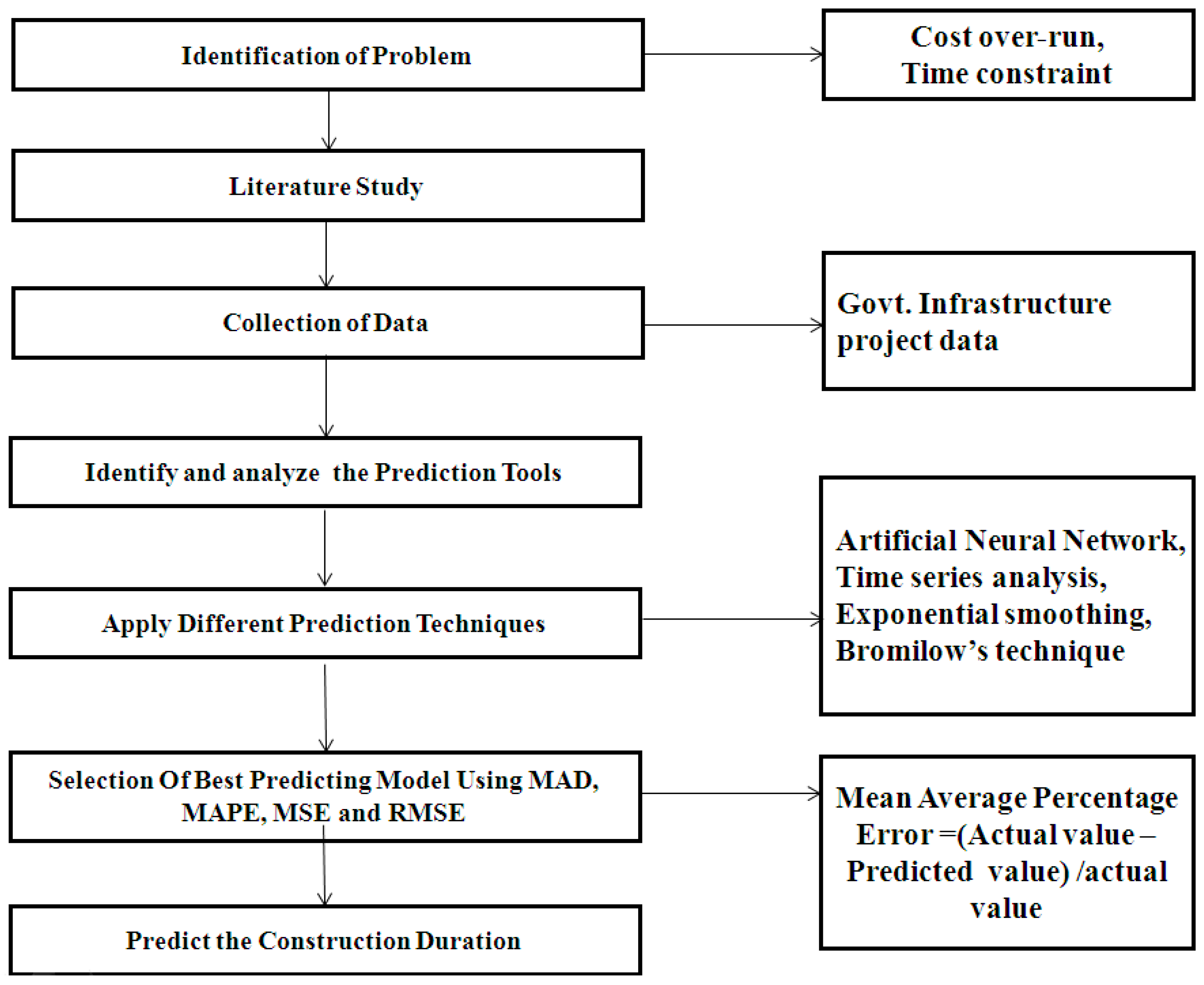
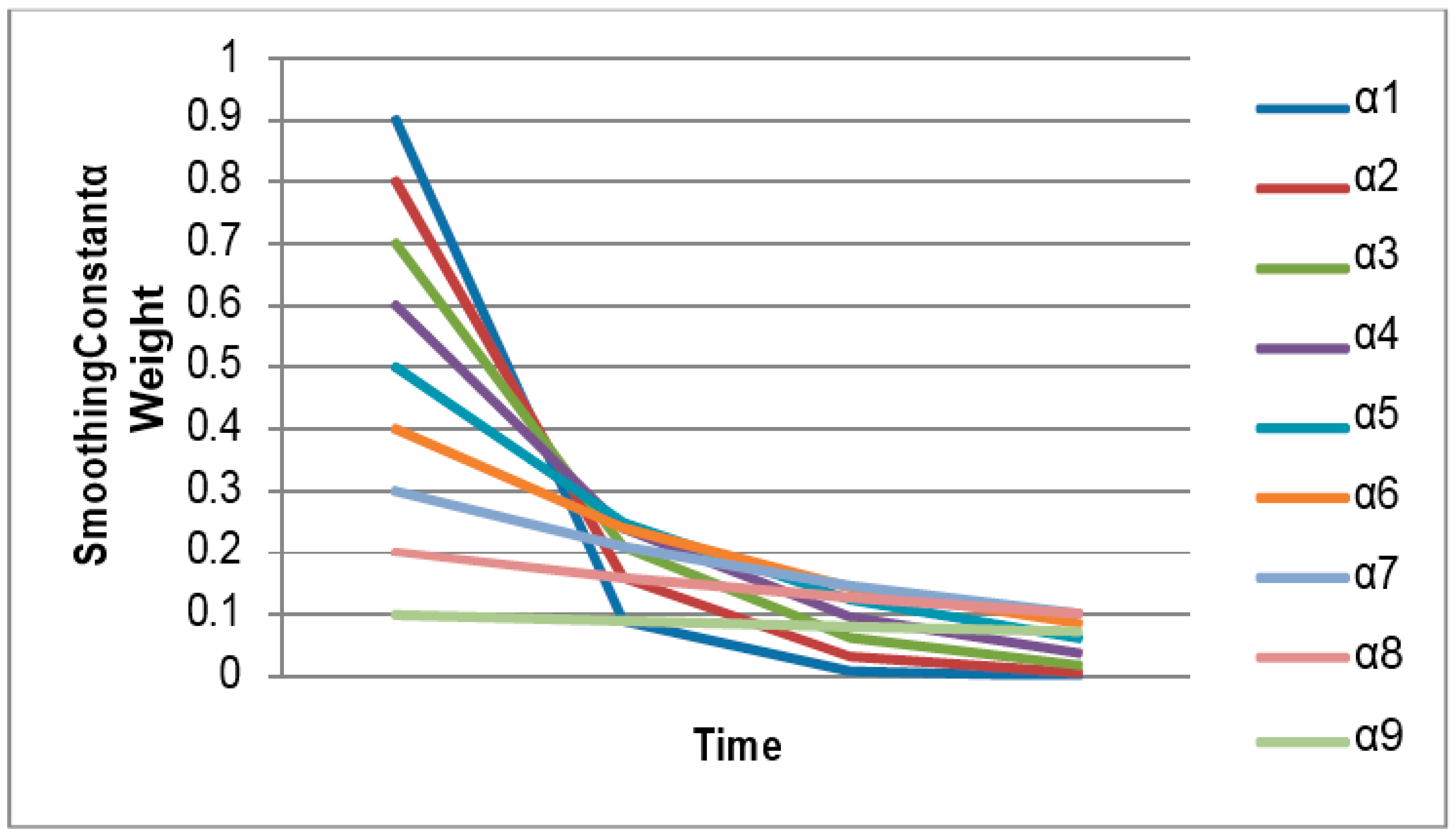
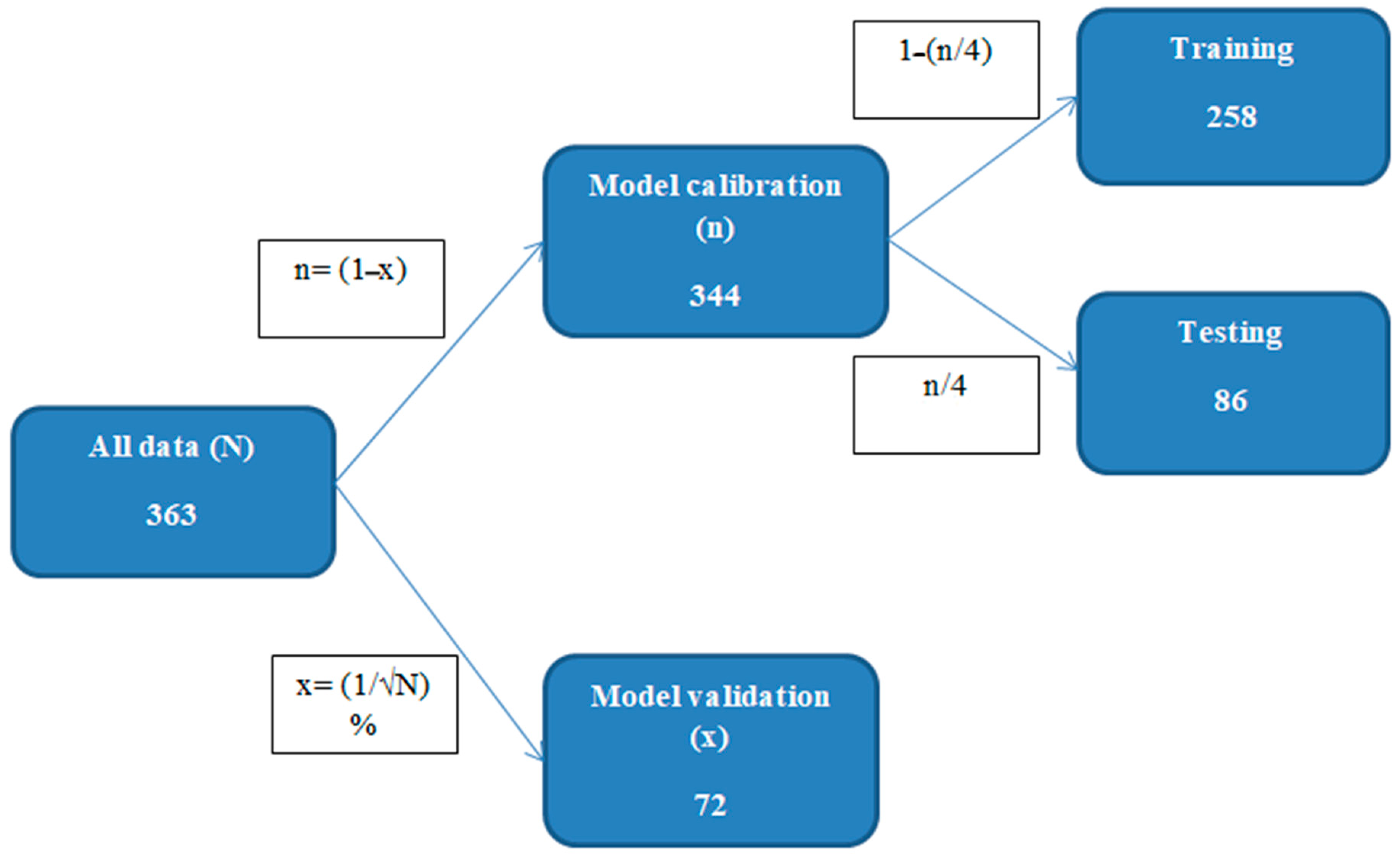
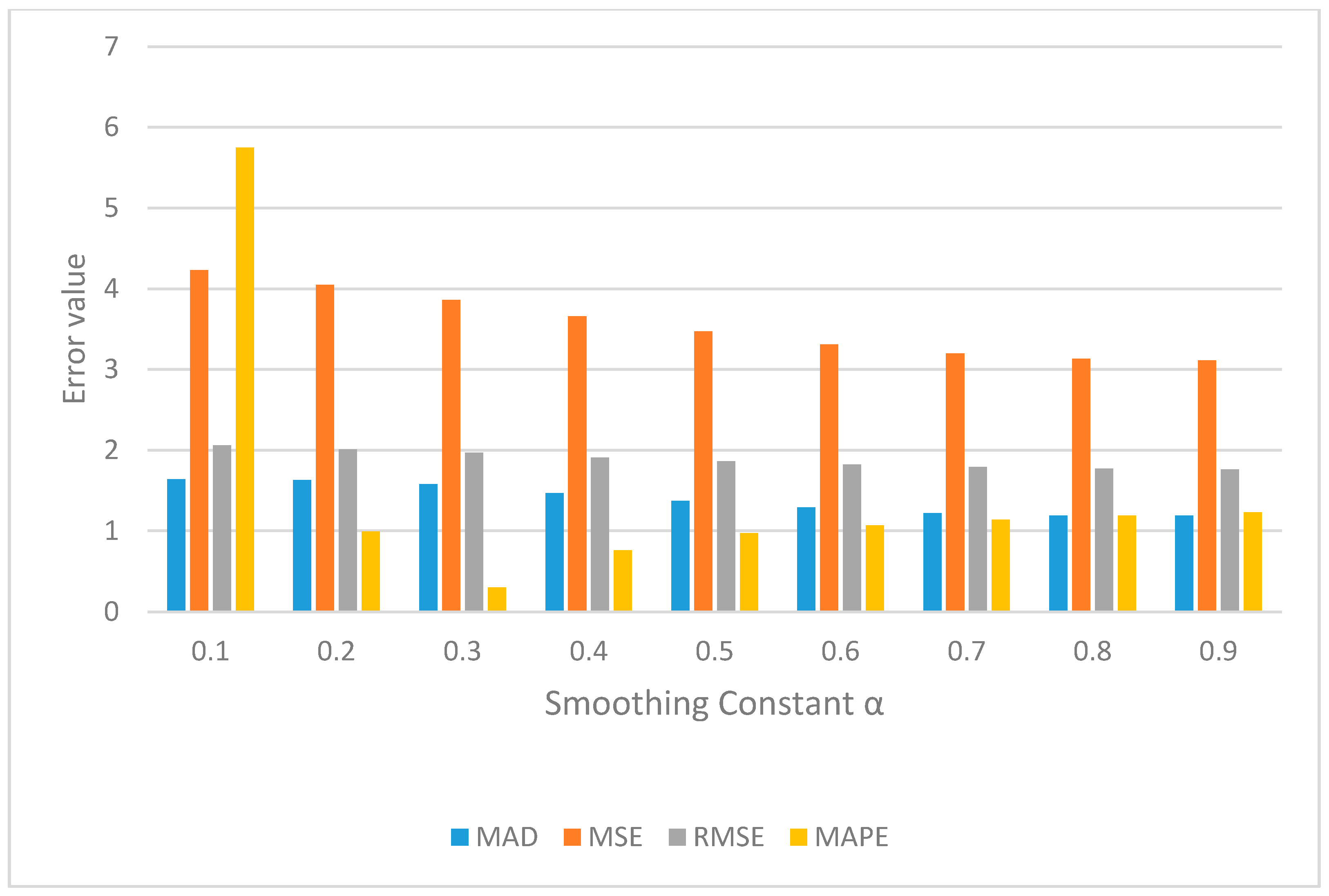
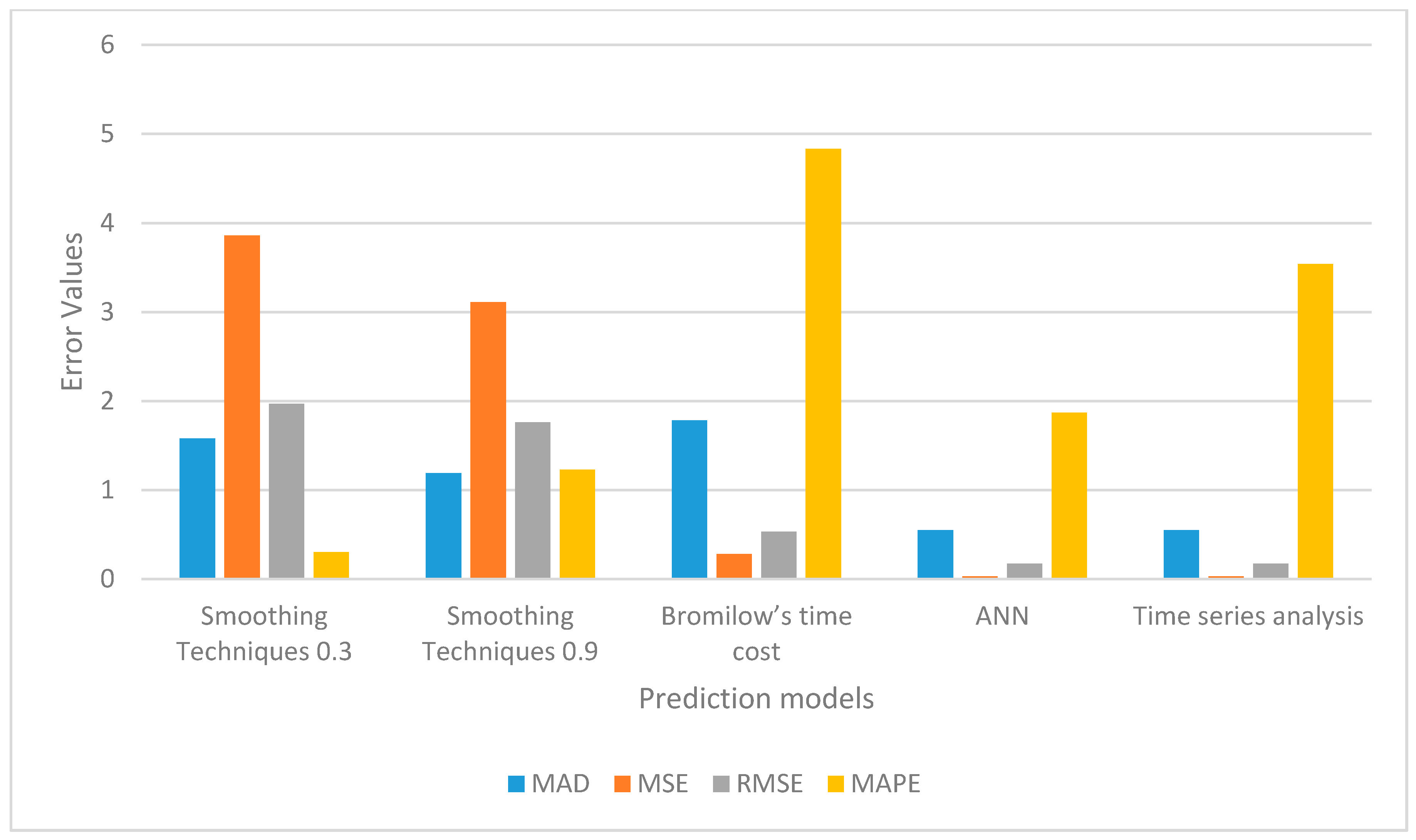
| Category | Classification | Quantity | Percentage |
|---|---|---|---|
| Highway sector | Public | 363 | 100% |
| Status | Completed (as on now) | 363 | 100% |
| Types | New project | 91 | 25% |
| Up gradation | 272 | 75% | |
| Government | Traditional | 363 | 100% |
| infrastructure project | Procurement | ||
| Authority | National level | 10 | 3% |
| (NHAI) | |||
| State level (PWD) | 353 | 97% | |
| Contract duration | <1 year | 67 | 18.5% |
| Planned | 1 year–2 year | 153 | 42.0% |
| 2 year–3 year | 94 | 26.0% | |
| 3 year–4 year | 23 | 6.3% | |
| 4 year–5 year | 10 | 2.8% | |
| >5 year | 16 | 4.4% | |
| Time overrun | >−25% | 20 | 5.5% |
| −10–−25% | 15 | 4.1% | |
| 0–−10% | 13 | 3.6% | |
| 0% | 101 | 27.8% | |
| 0–10% | 11 | 3.0% | |
| 10–25% | 36 | 9.9% | |
| >25% | 167 | 46.0% | |
| Contract cost (INR) | <50 | 32 | 8.8% |
| in Crore (One Crore = 10 Million) | 50–100 | 231 | 63.6% |
| 100–200 | 64 | 17.6% | |
| 200–500 | 31 | 8.5% |
| Time | t (1 − α) | t1 (1 − α)2 | t2 (1 − α)3 | t3 (1 − α)4 |
|---|---|---|---|---|
| Weight | ||||
| α1 | 0.9 | 0.09 | 0.009 | 0.0009 |
| α2 | 0.8 | 0.16 | 0.032 | 0.0064 |
| α3 | 0.7 | 0.21 | 0.063 | 0.0189 |
| α4 | 0.6 | 0.24 | 0.096 | 0.0384 |
| α5 | 0.5 | 0.25 | 0.125 | 0.0625 |
| α6 | 0.4 | 0.24 | 0.144 | 0.0864 |
| α7 | 0.3 | 0.21 | 0.147 | 0.1029 |
| α8 | 0.2 | 0.16 | 0.128 | 0.1024 |
| α9 | 0.1 | 0.09 | 0.081 | 0.0729 |
| Parameters | Values for 19 Validated Data | Values for 72 Calibrated Data |
|---|---|---|
| R | 0.908 | 0.851 |
| R Square | 0.824 | 0.725 |
| Adjusted R Square | 0.824 | 0.724 |
| St. Error of the Estimate | 0.691 | 0.651 |
| F Change | 1603.867 | 762.093 |
| Sig, F Change | 0.000 | 0.000 |
| Ln K | 2.313 | 2.343 |
| K | 10.105 | 10.105 |
| B | 1.003 | 0.888 |
| Minimum | Maximum | Mean | St. Deviation | N | |
|---|---|---|---|---|---|
| Predicted Value | −0.207 | 7.648 | 3.427 | 1.494 | 344 |
| Residual | −3.000 | 1.993 | 0.000 | 0.690 | 344 |
| St. Predicted Value | −2.432 | 2.825 | 0.000 | 1.000 | 344 |
| St. Residual | −4.343 | 2.885 | 0.000 | 0.999 | 344 |
| Error | 0.1 | 0.2 | 0.3 | 0.4 | 0.5 | 0.6 | 0.7 | 0.8 | 0.9 |
|---|---|---|---|---|---|---|---|---|---|
| MAD | 1.64 | 1.63 | 1.58 | 1.47 | 1.37 | 1.29 | 1.22 | 1.19 | 1.19 |
| MSE | 4.23 | 4.05 | 3.86 | 3.66 | 3.47 | 3.31 | 3.20 | 3.13 | 3.11 |
| RMSE | 2.06 | 2.01 | 1.97 | 1.91 | 1.86 | 1.82 | 1.79 | 1.77 | 1.76 |
| MAPE | 5.75% | 0.99% | 0.30% | 0.76% | 0.97% | 1.07% | 1.14% | 1.19% | 1.23% |
| Predicting Techniques | MAD | MSE | RMSE | MAPE |
|---|---|---|---|---|
| Smoothing Techniques 0.3 | 1.58 | 3.86 | 1.97 | 0.30% |
| Smoothing Techniques 0.9 | 1.19 | 3.11 | 1.76 | 1.23% |
| Bromilow’s time cost | 1.78 | 0.28 | 0.53 | 4.83% |
| ANN | 0.55 | 0.03 | 0.17 | 1.87% |
| Time series analysis | 0.55 | 0.03 | 0.17 | 3.54% |
| Prediction Techniques | Smoothing Techniques α 0.3 | Smoothing Techniques α 0.9 | Bromilow’s Time Cost Model | ANN | Time Series Analysis |
|---|---|---|---|---|---|
| MAPE | 1.20% | 5.02 | 21.17% | 7.70% | 15.12% |
Publisher’s Note: MDPI stays neutral with regard to jurisdictional claims in published maps and institutional affiliations. |
© 2021 by the authors. Licensee MDPI, Basel, Switzerland. This article is an open access article distributed under the terms and conditions of the Creative Commons Attribution (CC BY) license (https://creativecommons.org/licenses/by/4.0/).
Share and Cite
Velumani, P.; Nampoothiri, N.V.N.; Urbański, M. A Comparative Study of Models for the Construction Duration Prediction in Highway Road Projects of India. Sustainability 2021, 13, 4552. https://doi.org/10.3390/su13084552
Velumani P, Nampoothiri NVN, Urbański M. A Comparative Study of Models for the Construction Duration Prediction in Highway Road Projects of India. Sustainability. 2021; 13(8):4552. https://doi.org/10.3390/su13084552
Chicago/Turabian StyleVelumani, P., N. V. N. Nampoothiri, and M. Urbański. 2021. "A Comparative Study of Models for the Construction Duration Prediction in Highway Road Projects of India" Sustainability 13, no. 8: 4552. https://doi.org/10.3390/su13084552
APA StyleVelumani, P., Nampoothiri, N. V. N., & Urbański, M. (2021). A Comparative Study of Models for the Construction Duration Prediction in Highway Road Projects of India. Sustainability, 13(8), 4552. https://doi.org/10.3390/su13084552







